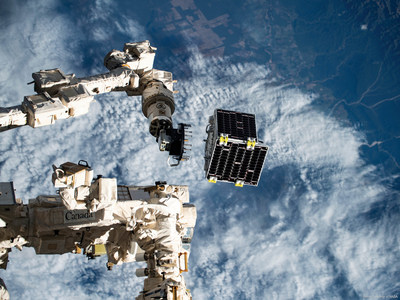Millennium Space Systems demonstrates advanced satellite constellation technologies
Rhea-AI Summary
Millennium Space Systems, a Boeing company, successfully demonstrated advanced technologies using its RED-EYE small satellite constellation on orbit. Built for DARPA, RED-EYE showcases capabilities such as aerodynamic drag modulation for orbital control, real-time on-board data processing, and multi-path communications. Launched from the International Space Station, the satellites were designed for a nine-month mission life but continue operating without degradation. RED-EYE highlights advancements in satellite constellations, offering cost-efficient operations and improved communication functionalities.
Positive
- Demonstrated advanced capabilities in satellite technology through RED-EYE.
- Continued operation of satellites beyond initial nine-month mission lifespan without capability degradation.
- Cost-effective orbital control using aerodynamic drag modulation without propulsion.
Negative
- The RED-EYE contract concluded in December 2021, which may impact future revenue opportunities.
News Market Reaction 1 Alert
On the day this news was published, BA gained 1.44%, reflecting a mild positive market reaction.
Data tracked by StockTitan Argus on the day of publication.
EL SEGUNDO, Calif., July 20, 2022 /PRNewswire/ -- Millennium Space Systems, a Boeing (NYSE: BA) company, demonstrated several new technologies – expected and unexpected – on orbit with their RED-EYE small satellite constellation. Built for DARPA, the satellite was nicknamed RED-EYE for the conspicuous bright red "remove before flight" cover used to keep the payload clean. The small satellites' purpose was to demonstrate new avionics, communications devices, on-board processors and crosslinks.
"Millennium is well known for wringing every possible utility out of small sats, and this was no exception," said Jason Kim, chief executive officer of Millennium Space Systems. "RED-EYE showed what's possible when it comes to advancing capabilities for small satellite constellations and resiliency. And we're demonstrating it on-orbit in a way that's cost and schedule efficient."
RED-EYE was able to control a constellation's orbital spacing through aerodynamic drag modulation and management in low Earth orbit. If the satellites needed to come together for a cross-link as an example, the Millennium team developed a simple method to manage their aerodynamic drag simultaneously to control the constellation spacing.
"Satellite propulsion is not always an option – since we launched off the International Space Station, we had to ensure that our space vehicles were safe for the astronauts onboard," said Doug Hulse, RED-EYE program manager, Millennium Space Systems. "Instead, we used a novel approach to orbital spacing which allowed us to control the satellite constellation and perform our demonstrations without propulsion."
The team took it a step further with space and ground-based automation, allowing the constellation to essentially self-control its orbital spacing.
While designed for a nine-month on-orbit mission life, the small satellites continue to operate today without capability degradation.
"RED-EYE is also performing real-time on-board processing," said Hulse. "Getting data down from a satellite can take a long time. If we can process raw data onboard and downlink only the information that we want to learn, we can really improve the latency of the system to provide that information to the users."
The program is demonstrating multi-path-communications on-orbit, creating a path to networked small sat constellations. Different communication layers can serve various functions – resiliency and multiple parallel missions – potentially for use in multiple domains.
The RED-EYE contract concluded in December 2021 and the first satellite decommissioned in June 2022. The satellites launched in 2019 and 2020 from the ISS.
Media Contact:
Dana Carroll, vice president, Marketing
Millennium Space Systems
dana.carroll@millennium-space.com
Millennium Space Systems, a Boeing Company, delivers high-performing prototype and constellation solutions across advanced national security and environmental observation missions. Founded in 2001, the company's small satellite missions support government, civil and commercial space customers' needs across orbits.
![]() View original content to download multimedia:https://www.prnewswire.com/news-releases/millennium-space-systems-demonstrates-advanced-satellite-constellation-technologies-301590314.html
View original content to download multimedia:https://www.prnewswire.com/news-releases/millennium-space-systems-demonstrates-advanced-satellite-constellation-technologies-301590314.html
SOURCE Millennium Space Systems









